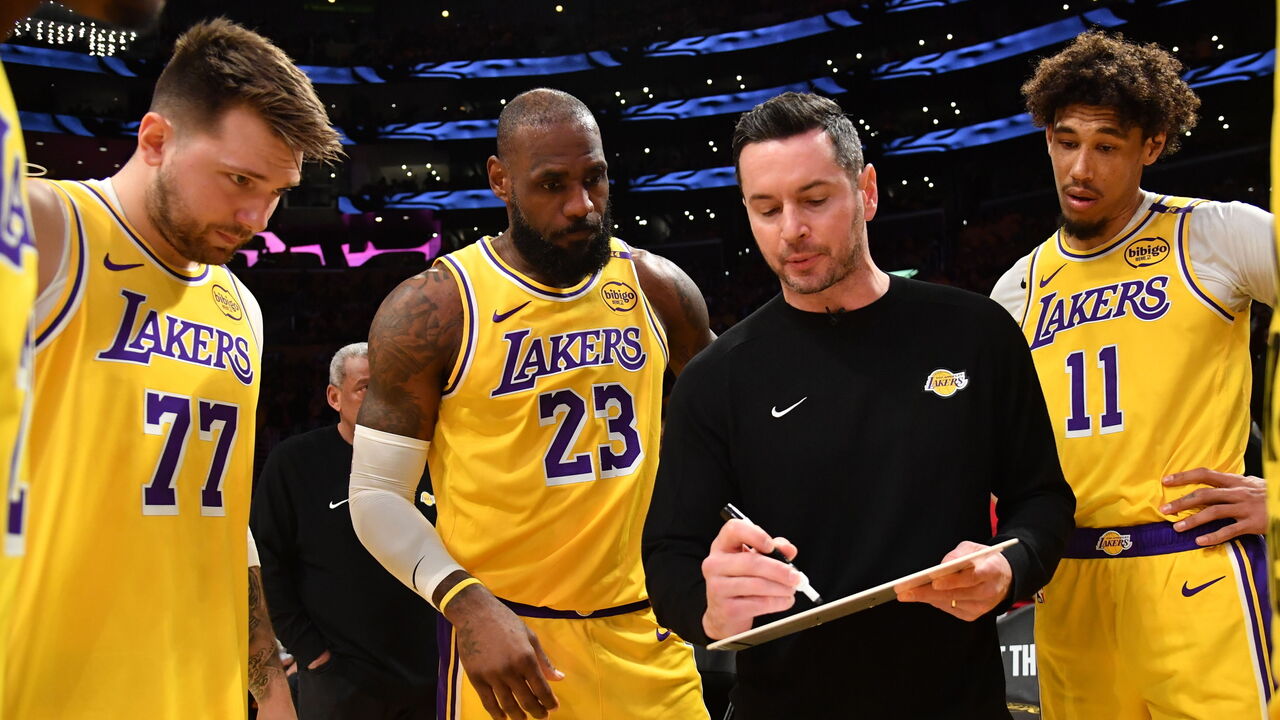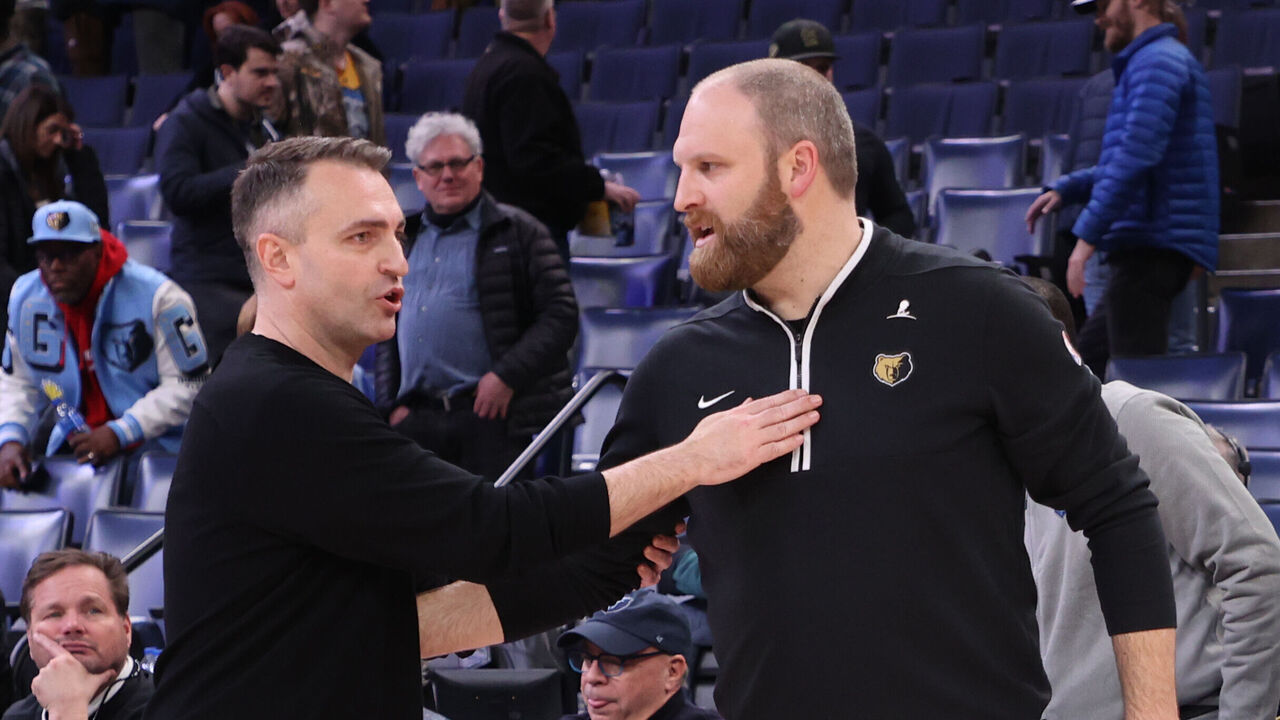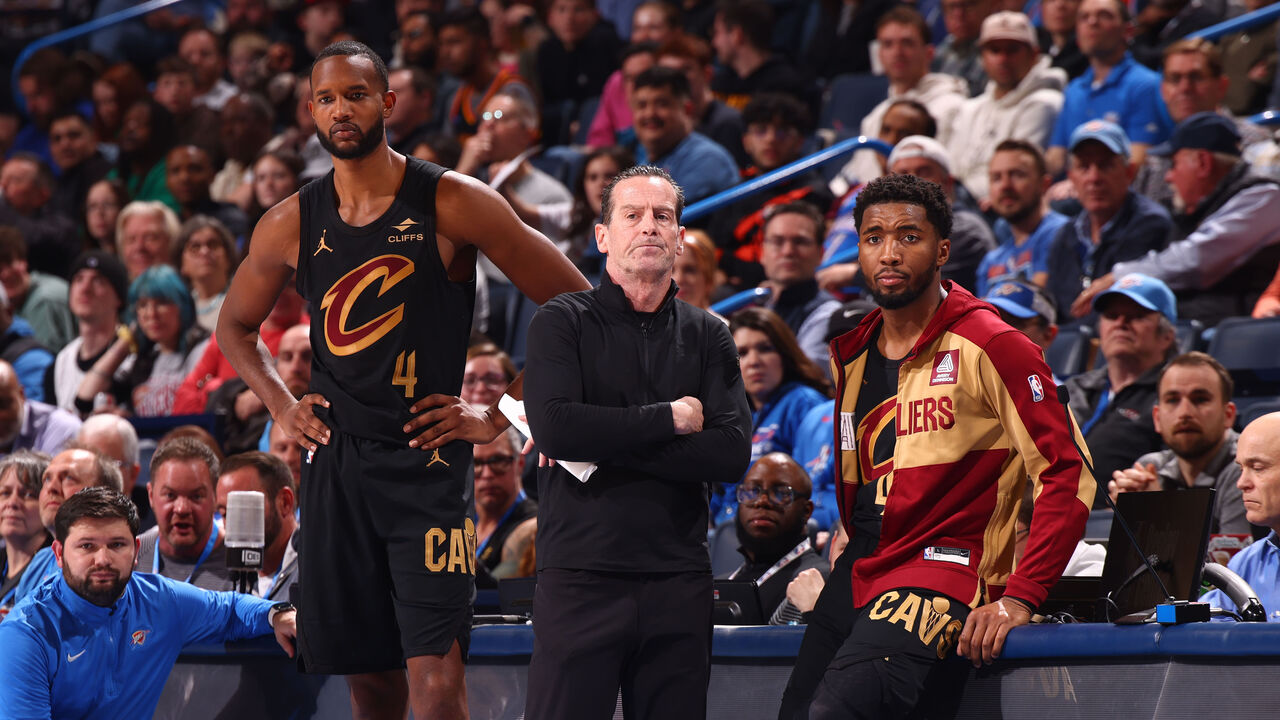NBA coaches on how evolution takes shape, and what comes next
NBA basketball mutates constantly, like just about everything in the world. Stylistic revolutions are met by counterrevolutions, and each season brings the exploitation of new tactical blind spots. As players' skill sets evolve, so does conventional wisdom.
The league's changed at head-spinning speed in recent years. We've seen the proliferation of 3-point shooting, pace, ball movement, and player movement. We've watched spread pick-and-roll usage explode, and recently we've seen it gently recede in favor of a shift toward high-post offense. We saw offensive rebounding de-emphasized and then re-emphasized, the latter tied to a recent league-wide obsession with winning the possession battle. We watched small ball grip the league for a time, and now we're seeing the pendulum swing back toward frontcourts with two bigs.
We've seen pick-and-rolls get inverted, and get ghosted, and expand into ornate three- and four-man actions. We've witnessed the rise of the dribble-handoff, and the widespread adoption of split action. And in response to all those offensive changes, we've seen an outpouring of defensive ingenuity, featuring various iterations of zone, dynamic pick-and-roll coverages, peel switches, pre-switches, scram switches, switch-doubles, full-court presses, and extreme cross-matches.
But how does all that stylistic change actually come about? Who or what drives evolution? And can the answers to those questions tell us anything about how the game will change in the future? Those are the questions I posed to a handful of head coaches around the league.
One thing the interactions hammered home is how much coaches have on their plates. On top of juggling myriad day-to-day tasks - game-planning for upcoming opponents, mapping out substitution patterns, balancing short- and long-term developmental priorities with a group of distinct personalities and fragile egos - they have to keep their eye on the big picture. That means recognizing where the game is moving or anticipating where it will move. It means constantly working to stay ahead of the curve, either by crafting novel schemes and actions or by seeing them elsewhere and incorporating them early. And it means being able to communicate new concepts in a way players can digest, so those concepts can be effectively put into action on the court.
I wanted to hear from different coaches about this for different reasons. There are guys like the Bucks' Doc Rivers, the Pacers' Rick Carlisle, and the Clippers' Ty Lue, who speak with decades of experience in the NBA as both players and coaches. They've witnessed more change than anyone. JJ Redick studied the league's evolving tactics over a 15-year playing career and then as a media member, and now he's putting his insights into practice as a first-year head coach with the Lakers. Mark Daigneault's been a fountain of creativity ever since becoming the Thunder's coach at age 34, spamming small-small pick-and-rolls and pushing the envelope with an aggressive defensive scheme that breaks a lot of conventional rules.
No team's done more to shape how the rest of the NBA is playing this season than Joe Mazzulla's defending champion Celtics (a lot of other coaches' answers speak to that), and now Mazzulla's trying to stay a step ahead of the imitators in his quest for a repeat. Steve Kerr's triangle-inspired motion offense and switch-heavy defense were as influential as any systems in the last decade; now he's trying to keep his Warriors competitive in a league they helped transform.
Kenny Atkinson spent years on Kerr's staff before taking the Cavaliers' head-coaching gig and revolutionizing their offense. Mike Brown did the same with the Kings before being fired this season. (I kept his answers mainly because he was the only coach who cited the challenge of trying to evolve midseason.) The Grizzlies' Taylor Jenkins installed an entirely new offense that's thriving by running way fewer ball screens than any other team. 76ers coach Nick Nurse helped popularize all kinds of janky defensive schemes, and took possession-game manipulation mainstream with the Raptors. And Darko Rajakovic, Nurse's successor in Toronto, came at these questions as the coach of a rebuilding team.
Here's what they all had to say. (Some answers were condensed for clarity.)
How coaches think about evolution

JJ Redick: "I think there's sort of two baskets there. One is the tactical stuff. There are certain actions that are very difficult to guard, so you're constantly looking at how other people are guarding them. Some defenses figure out how to guard them, and then you have to figure out the counter to that. Let's say, spread pick-and-roll: the way the coverage around that has evolved just in the last 10 years is really interesting, particularly as the ball goes to a double side. We call it a heavy. But there's a counter now to the heavy defense. Cleveland does it. Memphis does it really well.
"Then there's the margin basket. And that's, you know, looking at crash rate, offensive rebounding rate, generating threes, end of quarters, start of quarters, all those things. Like, how do you create margin in the game? (How do you) control the possession battle, and give yourself enough scoring opportunities to win? I think most teams are pretty well aware of that, and are investing a lot of time and thought around that."
Mark Daigneault: "All of our tactical decisions are a byproduct of who we have. It's not like we are on the drawing board saying, 'what's going to be the next big trend?' and trying to get out in front of that. It's more that we're on the drawing board trying to understand our players, and how to best leverage their strengths, and doing so without boundaries. If it's something that's unconventional, we're willing to explore that, but it's always in pursuit of what's best for our players.
"Some of the defensive stuff is a byproduct of our activity and how good some of our individual defenders are. That allows us to take pretty bold risks and still be able to recover on a lot of possessions, and kind of have our cake and eat it too in terms of disruption and also discipline. And then offensively, a lot of the stuff in the past is because we've been smaller and because our fives have been perimeter-oriented players. I think all that stuff is born out of the strength of the teams, and not necessarily a tactical brainstorm."
Steve Kerr: "Organizationally, you want to be able to match your roster with those trends. So, defensively, that's why we're all looking for 6-foot-8 guys who can switch and guard multiple positions. Offensively, we're all looking for players who can shoot. That's where the game has changed the most, I would say, even in my 10 years here - just the number of four- and five-men who can shoot. I look back at my first couple of years, there were so many games where the four and the five on the other team couldn't shoot. You could do anything you wanted defensively and cover ground because you didn't have to worry about two guys. So that's changed dramatically.
"But it's not easy, obviously, to put together rosters that make perfect sense for what's happening (in the league). Sometimes it's just, you hit a sweet spot like we did for five, six years, and you kind of nail all of that. And then you go through a period like we're going through now, trying to make it make sense. But I think that's kind of what the league is about. It's ever-evolving and you have to adapt to try to find the best formula to win."
Doc Rivers: "You always are thinking about it. Just thinking about different ways to score, different ways to defend. I've been successful, in my opinion, because I've stayed open-minded. I've been willing to try things that have been great, and some that have really failed. And I don't ever look back at it (with regret). I think it's important to be open-minded enough to try anything, because with our league and the talent ... this league is as talented as it's ever been. And you've gotta coach that, and you've gotta coach against that."
Taylor Jenkins: "We knew we had to be more efficient in the half court, not just rely on our pace and offensive rebounding, which we still want to thrive in, but how are we creating more quality shots? How are we creating more movement, more unpredictability on the offensive side? So the phrase that I came to in doing more research was: how are we moving based off of being in an invasion sport? It's all about space, at the end of the day. You're always trying to draw a second defender, or third defender. But how are you creating those advantages? Is that always ball screen? Is it always a drive? Or can it be more cuts and off-ball screens as well?
"We definitely leaned into that at the beginning of the season, and leaned away from pick-and-rolls a little bit more. So, it was harder to game plan, but we also understand that that's an advantage creator for us. Because it allows us to be harder to predict. What we're trying to do on the offensive side, our movement patterns, our guys know what to do. For the defense, it makes it a little bit harder for them to figure out."
Mike Brown: "We have some wrinkles that we put in this year, and we haven't gotten to them a lot. We're always thinking about (evolving), but, you know, that's one thing you have to always be careful of - you don't want to change too much, because then guys will never get comfortable or good at what you're trying to install. Defensively, it's not easy to go from zone to triangle-and-two to man and back to zone. You do it if you need it, and if it works, you stay with it. But if you keep changing, then guys will never believe in anything that you do."
On inspiration and staying ahead of the curve

Joe Mazzulla: "That's what you're constantly doing. Sometimes you don't know what to evolve to until the environment presents itself. So I think it's just staying aware of where we can find areas to do that. That's where you have to go to different lineups, different ways to impact the shot margin. It's just a constant, ever-changing thing. You're just staying aware of where you can further develop, where you can create new identities."
Kenny Atkinson: "That's a big part of it, right? Seeing trends in the league early. We keep a close eye on the NBA, and quite honest we keep an eye on Europe, what's happening in FIBA basketball. You've gotta be ahead of it. If you're late to the game then there's no competitive advantage."
Daigneault: "It's really about, what are the problems we're facing, what solutions can we come up with, and which other teams around the world face similar problems and have found solutions to those things? Because as you bang your head against the wall with problem-solving, that's how your solutions have integrity. If you can see what other people are doing and how they're solving their unique problems, then you can learn from that."
Darko Rajakovic: "I think that defensive schemes are something all of us coaches have been watching with other teams. For me, if I'm playing against a certain defense or defensive style that's creating a problem for our team, (I'm thinking), how are we going to solve that? And at the same time, is there anything for us to learn from that and apply with our own defense? I don't think there's any shame in trying to do something that's successful for other teams around the league. But everything is about what best fits your team.
"We spend a lot of time in the offseason looking for any competitive edge, something that we can implement with our guys. And there is always that balance between what you would like to do, and (the question of) does that fit your team? Does that fit your overall philosophy? But definitely we're always looking for that 1% that we can maybe be different or out of the box, in a way that can get us some advantage."
Jenkins: "It's an ongoing dialogue, as we're still processing what our team is capable of and what (it's) grasping. Coming into the season, it was like, what we did in previous years wasn't good enough, so we have to do something different. Let's lean into that. Let's study that. Let's see what opponents are going to do. Some have shown us some things that we have to be mindful of on a night-to-night basis. If a team has a different adjustment, how do we react? And then we drill that and teach that. So, you always want to stay ahead of your competition. This is an opportunity for us, and we're still collecting a lot of data to figure out how we can maintain that (edge)."
What changes are coming in the future?

Atkinson: "The game is changing so quickly, even in the last two years. Pace, obviously, is the No. 1 thing. The game is faster. But I think what you're also seeing is bigs handling the ball in these inverted pick-and-rolls. You know, I don't think they were running pick-and-rolls for Kareem (Abdul-Jabbar) back in the day. But even more recently, you didn't see a big guy handling and a small set (a screen) very often, and I think you're seeing more and more of that.
"We run a bunch and it's really hard to guard. So, I could see that being the next kind of thing, but it's already happening. And it's like, defensively, what do you do? Do you switch it? Do you play in a drop? Do you show? So I think we're going to keep seeing more of that."
Nick Nurse: "If you look at Boston, obviously they're just rolling along. And they put a team out there of 6-foot-5 and above, every guy. And they just spread the floor, give it to a guy who can play one-on-one and go score it. And then if you bring some help, they're gonna fire it to somebody who's a high, high, high-percentage 3-point shooter. And all of them can guard, they're all two-way players as well. And if you're not gonna match somehow the 3-balls that they make by making enough of your own, then the scoreboard's gonna start moving quickly in the wrong direction, right?
"So, I think trying to figure out how to either get those kind of players, create those kind of players, or figure out some type of strategy to limit (Boston) from taking 60 threes a game is what's on everybody's plate right now. ... There's some things you can do, but I can't be telling everybody right now. I mean, I'm still working on some of them."
Rajakovic: "I think what you're gonna be seeing more and more is diverse defenses. Because the skill level of players is such that playing one coverage, one scheme, is gonna be really hard. Players are so good offensively that they're gonna figure it out. And that's why you're gonna see more zone, matchup zone, full-court pressure. You're gonna see a lot more defensive schemes than you used to see in the past.
"But everything goes in cycles, you know? Like, zone defense was not made up three years ago. Zone has been part of basketball for 50, 60 years or more. And when you look at the championship-level teams, those are the teams that shape tendencies around the league. You look at Boston, everybody can shoot, everybody can switch one through five. They won the title, and now people might be looking more for those types of teams. Everything goes in cycles like that."
Ty Lue: "I think it's all a cycle, and I think we'll get back to dominant centers. Instead of having four or five in the league, you'll have 10, 12, 15 dominant centers. It's always five or six years where, you know, everything changes. And then it comes back to where it started."
Kerr: "I don't think a whole lot about what's next. ... I've never considered myself a visionary, to be honest with you. I think I inherited a team that fit my style 10 years ago, my eye and how I liked to play. And then I'd had a lot of experience with some visionaries, Mike D'Antoni being among them. He's the guy who I felt really changed the way the league started to think.
"But none of our teams have ever had a ton of 3-point shooting. All of our teams have been very top-heavy, so our theory my first few years was, let's shoot as many threes as possible, but let's make sure it's Steph and Klay shooting. And now what's happened is, you've got teams like Indiana (with) shooting from all five spots, and that's really hard to guard."
Rick Carlisle: "To me, it, it seems logical that it would be more speed, and then the center position becoming more skilled and being able to shoot from further out, top to bottom. It'll be more guys like Kristaps Porzingis and Myles Turner playing the five that can shoot 30-footers and protect the rim. And once that happens, defenses will be even more challenged."
Rivers: "Hopefully no more Wembys. One's enough. But life imitates art, and every big guy's out there shooting threes now. So, we'll see."